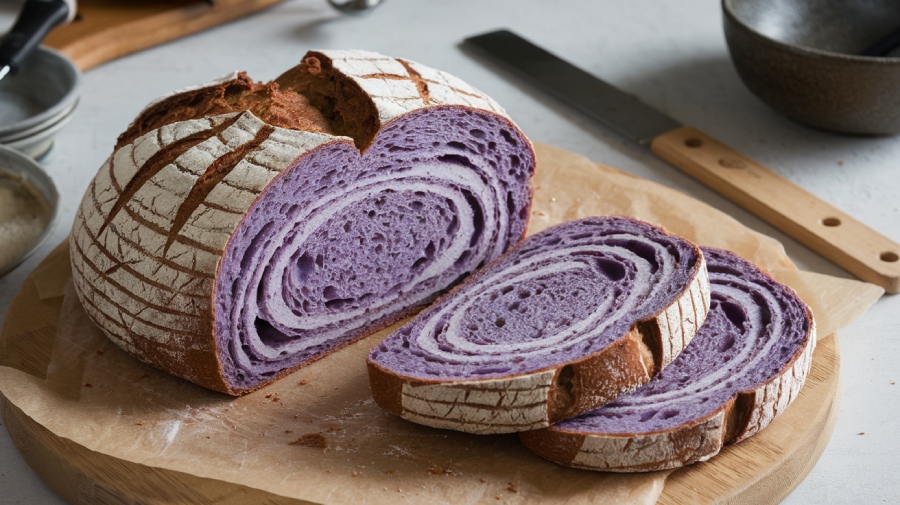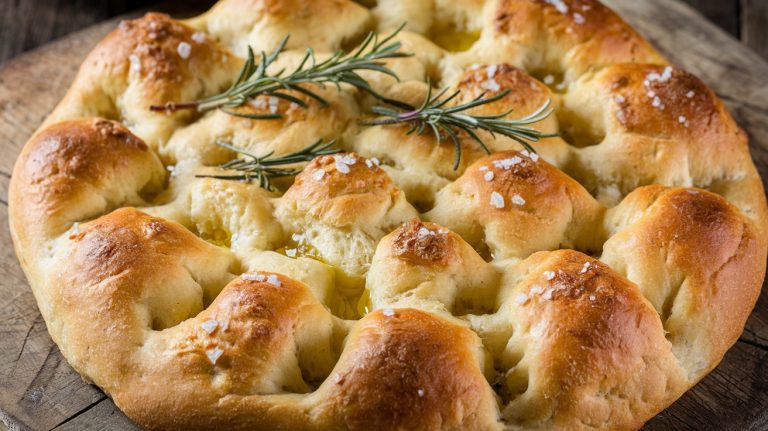Ube Coconut Milk Sourdough: Bright, Colorful and Healthy
Ube coconut milk sourdough marries the tangy charm of traditional sourdough with the vibrant, nutty sweetness of ube and the creamy depth of coconut milk. You’ll start with a robust sourdough starter, mixing in a blend of all-purpose and bread flour, ube powder, and full-fat coconut milk.
As the dough ferments, its texture becomes airy and flavorful. After a couple of rises, shape your loaf and bake it in a Dutch oven for that perfect crust.
This unique bread not only tastes incredible but also offers impressive health benefits. Discover more tips and recipes to elevate your baking experience.
Key Takeaways
- Ube powder and coconut milk enhance the flavor and moisture of sourdough, creating a unique tropical twist in the bread.
- A mature sourdough starter is essential for proper fermentation, providing rise and complex flavors to the ube coconut milk sourdough.
- Incorporate desiccated coconut for added texture and flavor, and consider using ube jam as a filling for a deeper ube experience.
- Monitor fermentation times carefully; a warmer environment speeds up the process, while cooler temperatures slow it down for better flavor development.
- Utilize a Dutch oven for baking to achieve a crusty exterior while maintaining moisture within the loaf.
Ingredients Needed for the Recipe
When diving into the delightful world of Ube Coconut Milk Sourdough, you’ll find that the right ingredients are fundamental for crafting a loaf that’s both flavorful and visually stunning.
Start with a blend of all-purpose and bread flour, which gives your dough the perfect balance of structure and tenderness. Ube powder is a star ingredient, typically ranging from 25-52 grams, adding a beautiful purple hue and a distinct flavor.
A mature, active sourdough starter is essential for that delightful rise, as a mature sourdough starter significantly contributes to the bread’s texture and flavor. Coconut milk, whether full-fat canned or unsweetened carton, introduces moisture and a hint of tropical flavor.
For sweetness, brown sugar not only enhances taste but also regulates bacterial activity during fermentation.
Don’t forget desiccated coconut, which boosts texture and enhances the overall flavor profile. If you want to deepen the ube experience, consider using ube extract or even store-bought ube jam.
A touch of melted butter or an egg can add richness, while salt is crucial for flavor and structure.
Preparation Steps
Crafting your Ube Coconut Milk Sourdough begins with a series of straightforward yet essential preparation steps that guarantee your loaf turns out beautifully.
Start by activating your sourdough starter; mix it with water, sugar, and flour, allowing it to double in volume. Once it’s ready, combine your wet ingredients in a large bowl, gradually adding the dry ingredients while kneading until no dry traces remain. Incorporating ube coconut rolls into your baking repertoire can enhance the flavor and texture of your bread.
Transfer your dough to a lightly greased bowl and let it bulk ferment in a warm place for about 3 to 4 hours until it’s doubled in size.
After this initial rise, give the dough a short rest before rolling it out into a 12 by 14-inch rectangle. Spread the ube filling evenly on top, then roll the dough into a log.
For shaping, split the log in half lengthwise, twist the halves together, and transfer your coiled dough to a parchment-lined Pullman pan.
Allow it to rise again in a warm spot until puffy, about 2 to 3 hours, before considering any cold proofing overnight.
Baking Process
Now that you’ve prepared your dough, it’s time to focus on the baking process.
Understanding fermentation timelines and mastering dough preparation techniques can make all the difference in achieving that perfect loaf. Proper proofing techniques are essential as they significantly affect the texture and flavor of your sourdough.
Plus, a few baking tips and tricks will help you elevate your ube coconut milk sourdough to new heights.
Dough Preparation Techniques
In the art of creating Ube Coconut Milk Sourdough, mastering dough preparation techniques is essential for achieving that perfect balance of flavor and texture.
Start by combining your wet ingredients—coconut milk, melted butter, egg, and Ube extract—in one bowl, while mixing your dry ingredients—flour and ube powder—in another. Once both are ready, add the levain or sourdough starter, mixing until fully incorporated. This is crucial as the incorporation of sourdough starter enhances the depth of flavor in the final product. A well-prepared dough benefits from temperature control features that help maintain ideal fermentation conditions.
Here’s a quick rundown of key steps to follow:
- Kneading: Knead the dough for 5-7 minutes, either by hand or with a stand mixer, to develop gluten.
- Resting: Transfer the dough to a greased bowl, cover, and let it rise until it doubles in size, usually overnight.
- Salt Addition: After the first rise, incorporate salt and knead until the dough is smooth and not tacky.
Fermentation Timelines Explained
Understanding fermentation timelines is key to mastering the baking process for Ube Coconut Milk Sourdough. It all begins with the initial mixing of your starter, flour, and water, kicking off the fermentation cycle. Right after you mix, bulk fermentation starts, typically lasting between 4 to 12 hours. This duration varies based on ambient temperature and hydration levels, so keep an eye on your dough.
During bulk fermentation, you’ll notice your dough doubling in volume and transforming into a smooth, puffy texture—these are signs of successful fermentation. Remember, temperature plays a significant role; warmer conditions speed up the process, while cooler ones slow it down. If you’ve opted for higher hydration, be prepared for a quicker fermentation that can be challenging to manage. Additionally, understanding fermentation dynamics allows you to adjust the timeline to fit your schedule. Maintaining an optimal dough temperature is essential for achieving the best results.
Once bulk fermentation is complete, it’s time for folding and shaping, which strengthens the gluten network essential for your loaf’s structure. Be cautious not to over-ferment your dough, as this can lead to a sticky mess.
Baking Tips and Tricks

Baking Ube Coconut Milk Sourdough is as much an art as it’s a science, and mastering a few essential tips can elevate your bread-making experience. Start with a strong, active starter—this is your foundation. A sourdough starter is crucial for capturing the wild yeasts and bacteria needed for leavening.
Consider the following key techniques to guarantee success:
- Autolyse Process: Mix your flour and water, then let it rest for 30 minutes to an hour. This improves dough texture greatly.
- Stretch and Fold: Incorporate this technique during bulk fermentation to strengthen the dough without overmixing.
- Baking Vessel: Use a Dutch oven to trap heat and moisture, creating that perfect artisan crust.
Pay close attention to your environment; a warm spot around 27-28 degrees Celsius is ideal for proofing.
Always measure ingredients accurately with a digital scale for consistent results. When it’s time to bake, preheat your oven well, and remember to score your dough. This allows steam to escape, promoting even expansion.
Finally, cool your bread on a wire rack for at least an hour before slicing to avoid a gummy texture.
Recipe Variations
Experimenting with variations of Ube Coconut Milk Sourdough can lead to delightful new flavors and textures that elevate your baking game. You can play around with ingredients like unsweetened desiccated coconut or sweetened coconut flakes, depending on your sweetness preference.
For an authentic ube flavor and vibrant color, ube powder and ube extract are essential, but ube jam works just as well. Additionally, consider incorporating custard for dipping to enhance the overall flavor profile of your dish.
Consider different preparation methods, like the Tangzhong or Yudane techniques, which create a softer, moister crumb. Incorporating your sourdough starter not only boosts nutrition but also enhances flavor.
When it comes to filling, mixing ube halaya with cream cheese adds a delightful richness. You might also enjoy adding coconut oil and ube extract to intensify the flavors.
For a unique twist, try using an air fryer to bake—this method can yield a perfectly textured loaf. Finally, remember to allow your levain to triple in size for the best results.
Comparing Ube Sources
When you immerse yourself in the vibrant world of ube, you’ll discover that not all sources of this beloved purple root are created equal.

Ube and taro, while both popular, offer distinctly different flavors and textures. Taro presents an earthy, starchy taste best suited for savory dishes, whereas ube delights with its nutty sweetness, often compared to hints of pistachio and vanilla, making it a favorite for desserts.
When it comes to ube itself, you’ll find two main forms: ube extract and ube powder. Ube extract delivers a concentrated flavor that shines in bold recipes, while ube powder provides a milder taste and adds texture, perfect for baked goods and smoothies.
Plus, ube powder retains more fiber, making it a healthier choice.
If you’re exploring alternatives, consider Okinawan sweet potatoes. They share some flavor similarities with ube but have a lower Glycemic Index.
Ube’s thick, bark-like skin and longer growth cycle further differentiate it.
Natural Preservation Method
The unique qualities of sourdough baking extend beyond flavor to include impressive natural preservation methods. When you choose to bake sourdough, you’re embracing a healthier alternative that maintains its freshness longer than bread made with commercial yeast. This is thanks to the natural processes involved, particularly the lactic acid produced during fermentation.
Consider these benefits of sourdough’s preservation methods:
- Longer Shelf Life: Sourdough bread can last considerably longer due to its natural acidity.
- Mold Prevention: Lactic acid bacteria create an environment that limits harmful microorganisms.
- Healthier Ingredients: You avoid synthetic preservatives and rely on natural components. Additionally, incorporating natural preservatives like vinegar can further enhance the shelf life of your sourdough.
These mechanisms work harmoniously to enhance your bread’s longevity. The natural acidity lowers the pH, making it inhospitable for pathogens, while the wild yeast contributes to unique characteristics.
Plus, processes like autolyse and overnight retardment help retain moisture.
When storing your sourdough, remember to cool it completely before placing it in a cool, dry environment, ensuring it stays fresh and delicious for days to come.
Frequently Asked Questions
Can I Use Gluten-Free Flour for This Recipe?
Yes, you can definitely use gluten-free flour for this recipe!
Opt for a gluten-free blend that includes xanthan gum, which helps mimic the elasticity gluten provides.
You’ll want to adjust the water based on your starter’s hydration level.
Keep in mind that the baking process may require some experimentation, as gluten-free dough behaves differently.
With careful attention to ingredients and ratios, you’ll create a delicious and unique gluten-free bread experience!
How Should I Store Leftover Ube Coconut Milk Sourdough?
To store leftover sourdough, you’ll want to keep it breathing, cool, and protected.
Use a cotton bread bag or wrap it in a tea towel to maintain its crust. For an uncut loaf, let it sit at room temperature; for a cut loaf, place the cut side down, covering it with a towel.
If you need longer storage, freezing it’s ideal. Just remember, avoid plastic and refrigeration to keep it fresh!
What Can I Substitute for Coconut Milk?
If you need a substitute for coconut milk, consider using unflavored soy milk for a protein boost, or dilute coconut cream with water for a similar flavor.
Almond and oat milk work too, but they might change the texture a bit. Silken tofu can add creaminess, while whole milk serves well in baked goods.
Greek yogurt thickens recipes nicely, and you can even blend shredded coconut with water for a homemade option.
How Can I Enhance the Ube Flavor Further?
To enhance the ube flavor, try experimenting with various forms of ube. Start by incorporating ube extract for a more intense taste and vibrant color.
You can also blend ube powder into your mixture for added texture. Mixing ube with complementary flavors like coconut or vanilla can deepen the overall profile.
Just remember to adjust the amounts gradually; you want to find the perfect balance where the ube truly shines without overpowering other flavors.
Is There a Recommended Way to Reheat the Bread?
Is there anything better than warm, freshly reheated bread?
To reheat, preheat your oven to 350℉. If it’s frozen, defrost it first. For a crisp crust, brush the loaf with water or wrap it in aluminum foil. Heat for 10-15 minutes, depending on size.
Prefer slices? Use a toaster oven at 325℉ for 5 minutes.
Enjoy the delightful aroma as it fills your kitchen, enhancing your next meal!
The Nutritional Powerhouse of Ube Coconut Sourdough
Incorporating ube and coconut milk into your sourdough not only adds vibrant color and delightful flavor but also connects you to a thriving tradition. Did you know that sourdough fermentation can increase the bioavailability of nutrients, making your bread easier to digest?
As you savor each slice, you’re not just enjoying a unique treat; you’re also benefiting from the healthful aspects of fermentation. So, get baking and embrace the delicious fusion of flavors that this recipe offers.







